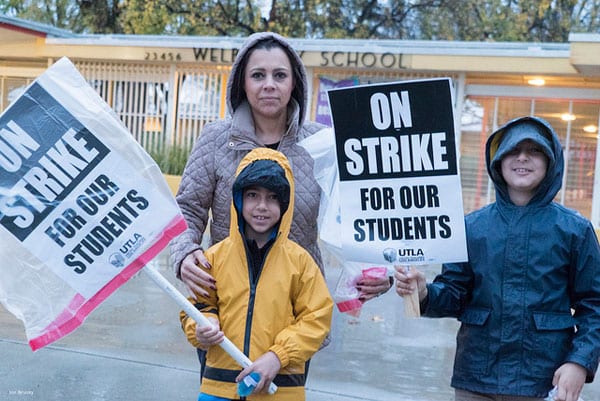
March 7, 2019; Governing
“For the past year, most teacher strikes aimed at boosting education funding have been getting results,” writes Liz Farmer in Governing. But there is still a lot of lost ground from the past decade.
A study by Michael Leachman and Eric Figueroa of the Center on Budget and Policy Priorities finds increased per-student education funding in four of the five leading states of 2018’s #RedforEd Strikes.
Four of the five states that experienced widespread teacher strikes in 2018 have significantly increased education funding this year, according to the study. The one-year changes in funding (2018–2019 vs. 2017–2018) are as follows.
| Oklahoma | +19% |
| Arizona | +9% |
| West Virginia | +3% |
| North Carolina | +3% |
| Kentucky | -0.3% |
Still, Farmer adds, “even with the increases, none of these states are close to what they used to put into K-12 education before the Great Recession. The deficit ranges from six percent below pre-recession levels in Arizona to 15 percent in Oklahoma.”
Sign up for our free newsletters
Subscribe to NPQ's newsletters to have our top stories delivered directly to your inbox.
By signing up, you agree to our privacy policy and terms of use, and to receive messages from NPQ and our partners.
Leachman, who coauthored the report and is CBPP’s senior director of fiscal policy, “cautions that three of the four protest states that raised education funding are relying on what he believes to be unsustainable revenue sources.” Arizona’s 20 percent pay raise over three years, for instance, assumes, according to Leachman, “rosy economic growth” predictions that rely on slower growth in Medicaid spending to make room for the increased per-pupil education commitments. Oklahoma went further than Arizona and raised taxes on cigarettes and gas to fund higher salaries, but, even so, if efforts to reduce cigarette and oil consumption in the state succeed, that would reduce the education revenue increases.
Of course, as NPQ has covered, #RedforEd strikes have continued this year, including in West Virginia (again) and in Denver, Colorado, and in the California cities of Los Angeles and Oakland. In Colorado, the CBPP report indicates that inflation-adjusted, per-student spending statewide remained one percent lower in 2016 than in 2008. In California, per-student spending increased by nine percent between 2008 and 2016, but per-pupil funding in California still is less than one-half the funding level ($8,961 vs. $18,719) of New York state.
Budget levels matter. A 2015 article published in the Quarterly Journal of Economics, for instance, found that a “10 percent increase in per pupil spending each year for all 12 years of public school leads to 0.31 more completed years of education, about seven percent higher wages, and a 3.2 percentage point reduction in the annual incidence of adult poverty.” The authors add that beneficial effects are even greater for children from low-income families.
As for state budget proposals for 2019–2020, these are still being finalized, notes Farmer, but a hopeful sign is that 18 governors so far have proposed raises for teachers for the coming fiscal year, according to National Association of State Budget Officers. “Chief among them,” Farmer adds, “are states that haven’t yet seen teacher unrest but that still have some of the largest education funding deficits: Georgia, Nevada, New Mexico and South Carolina.”—Steve Dubb













